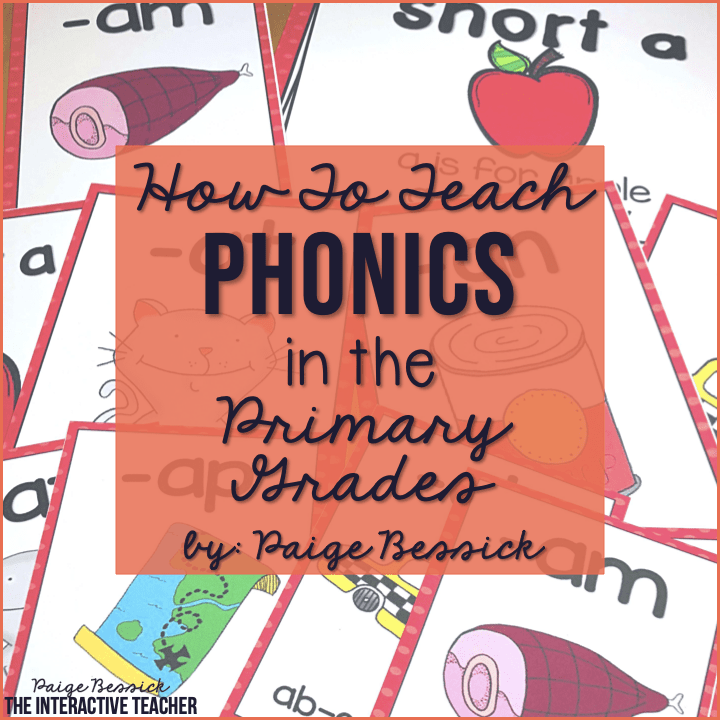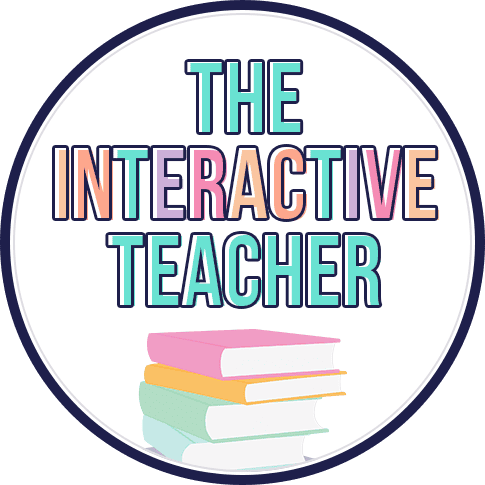Reading fluency is the ability to read accurately, smoothly and with expression. While we most often talk about it in the upper grades, reading fluency is an important element of learning to read in the primary grades as well. I’ll be sharing my #1 tip for improving reading fluency and three ways to do it.
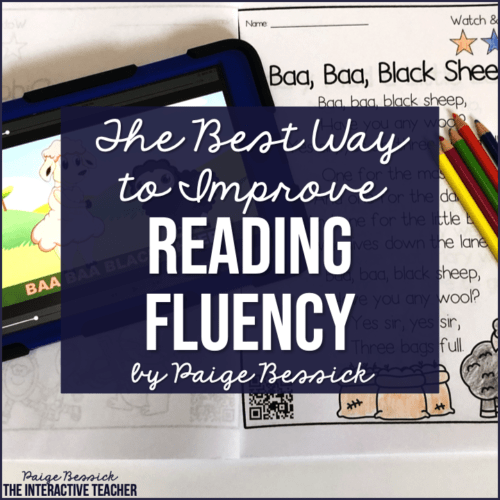
What is reading fluency?
Reading fluency is the ability to read all of the words correctly, sound smooth as you read, while also adding in expression and feeling. Fluent readers are able to recognize words quickly while not struggling over how to decode the words. Fluency is the bridge between reading the words and comprehension. It is said that if you are not a fluent reader, comprehension is more difficult. If a student is trying to read a text and is having a hard time reading the words and is having to decode words, they are not able to focus on what’s going on in the story. Ultimately, making comprehension difficult.
My district uses the Fountas and Pinnell Benchmark Assessment. Based on their guidelines, a fluent reader should be reading with 95% accuracy at levels A-L. Readers at level J and above can start being timed for their reading to check fluency rates. They should be reading 75-100 correct words per minute. This is an end of the year first grade level. Once students read at a level L and above, accuracy increases to 98% words correct and words read correctly per minute also increases. Check out >>THIS<< chart to see their guidelines for oral reading rates.
One of the only times I am checking for oral reading fluency with my first graders is during our assessments, three times a year. And only when they are reading at a level J and above.
With that said, I am often keeping in mind my students’reading fluency abilities and I will pull strategy groups to work on it throughout the year.
Why is fluency important?
As I said above, fluency is the bridge between reading the words and understanding the text. I found >>THIS<< website that talks more about fluency and why it is important.
Readnaturally.com says
For many years, educators have recognized that fluency is an important aspect of reading. Reading researchers agree. Over 30 years of research indicates that fluency is one of the critical building blocks of reading because fluency development is directly related to comprehension.
You can tell when a student is reading fluently because they sound natural as if they were talking. If a student has fluency issues, they will be reading word.by.word, going slow, decoding many words, not stopping at punctuation and it just doesn’t sound smooth. Have no fear! If you have a student with fluency concerns, it can be fixed and it can improve.
How to improve reading fluency
So now that you know what it is and why it’s important, let’s talk about what we can do to help our students improve their fluency.
Today, I’m going to talk about my #1 way to improve fluency.
REPEATED READINGS
Repeated reading is when you repeat a reading, over and over again. Giving our students a model of what it looks and sounds like to be a fluent reader is one of the best things we can do. The more we can reread something the better.
Here are three ways you can increase the number of repeated readings you do in your classroom.
1. Shared reading
First, shared reading is one of my favorite activities in my first grade classroom. It’s a literacy activity where you get so much bang for your buck. I’m all about doing more of things that help in a lot of ways. If you’re not familiar with shared reading, you can check out my blog post >>HERE<<. It talks all about shared reading and why it is so important.
Ultimately, shared reading is when you read a book with your class for 5 days. Each day you focus on a different skill. You pick a book just above your student’s reading level and read it each day. Simply by rereading the book each day, your students are practicing their fluency.

The fourth day of shared reading has a focus on fluency. On that fourth day, I often teach or reteach the importance of punctuation, including reading the ending punctuation, adding expression for exclamation points or question marks and thinking about quotation marks and when characters are talking.
Each day, however, you are choral reading with your students, so each day they get to hear you read it fluently. You are giving them a fluent model and they also get to practice reading the book with you each day. They practice their sight word recognition, comprehension, vocabulary and more each day, but rereading and fluency are a big part of every day as well.
Again, check out >>THIS<< blog post to learn more!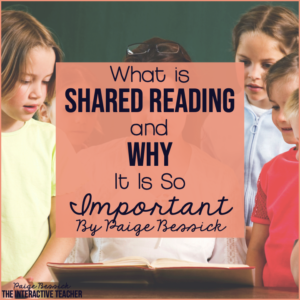
2. Listen to reading
Second, you can improve your students’ fluency skills is having them listen to reading. I’ve said earlier, that the more times a student can hear a fluent reader as a model, the better. While shared reading and read alouds are a great way for students to listen to reading, they can get even more practice on their own and independently by listening to reading.
You can use apps or websites like EPIC!, Raz Kids, and a new one I just found Unite for Literacy, that will give students the opportunity to listen to books read to them. I’m sure there are other apps and websites that do this as well. EPIC! and Unite for Literacy are FREE! Raz Kids is a paid app, but totally worth it if you have iPads or funds for apps.
I recently created a new resource to support my most emergent readers and this is another way to increase those repeated readings in your classroom.
QR Code Nursery Rhymes & Videos
Nursery rhymes and poems are another great way for students to get those repeated readings. Nursery rhymes are catchy and often have tune so it makes them fun to read and listen to.
My newest resource includes QR codes and printables that have the nursery rhymes and videos with those nursery rhymes. Have students listen to the songs and fluent readers read/sing the rhymes is a great way for students to practice their fluency. Nursery rhymes can be listened to again and again and providing your students with them in video and printable form will help them increase their overall reading and fluency skills.
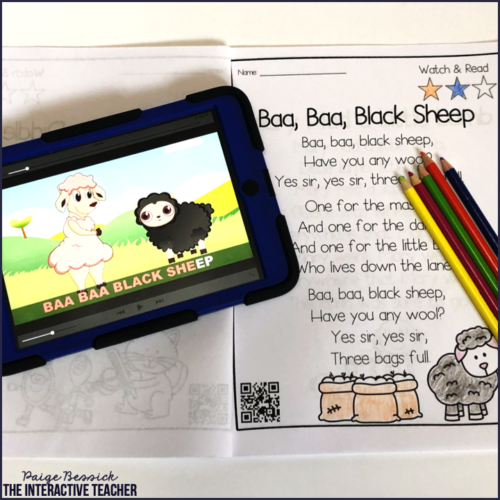
I love having activities that my students can do independently. Have a book for each of them, weekly rhymes for them to practice, or cards to search for around the room. All they need is an iPad to watch and listen to 10 popular nursery rhymes. My students LOVE these and I know yours will too!
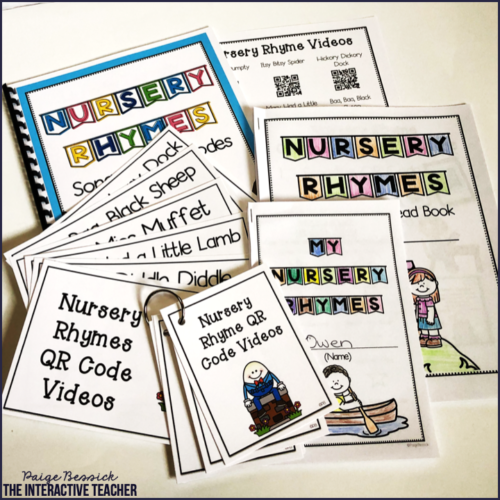
This watch and read resource includes printable books, cards to use during morning work, centers, extra time or to send home with students. Check out this new resource >>HERE<< or by clicking on the image below. 
3. Poem Binders
Last, you can increase the number of repeated readings in your classroom by introducing poem binders. I’ve been doing poem binders since I started teaching over 13 years ago and it’s one of my students’ favorite things each year.
As a shared reading activity each day to get ourselves ready to read, we do shared reading of poems. These can be poems about current holidays, phonics skills or activities that are going on in your classroom. We take 4-5 days to read the poems.
We have a set routine and procedure for each of the poems we read, similar to shared reading of books as mentioned above.
- Day 1: echo read the poem and discuss any vocabulary or tricky parts of the poem
- Day 2: choral read and play guess the covered word for 2-3 words focusing on word solving strategies
- Day 3: choral reading and highlight important sight words or words with phonics skills we’re learning
- Day 4: choral read and focus on fluency
- Day 5: students read for a final reading, putting it all together
On the fifth day, I typically introduce another poem. With each poem we read, my students get a hard copy that is three-hole punched. We put these poems into a binder throughout the year. When they get the printed copy, students are allowed to color the illustrations or illustrate it themselves if there is no clipart to color. If it’s a phonics poem, they get to highlight the phonics skill and write those words on the back of the poem.
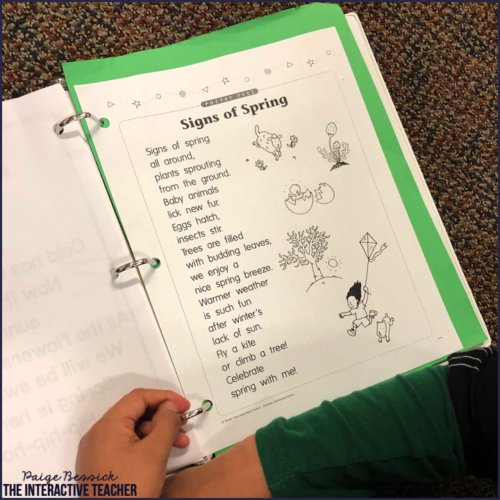
When students finish an activity early, as a morning activity or when there is a sub, students pull out their poem binders are reread the poems inside. At the end of the year, they take this binder home to share with their famlies and to practice reading throughout the summer. I have old students who come back and tell me they still have their poem binder from first grade.
This is another easy way to get in those repeated readings and improve fluency.
Other ways to improve fluency
While repeated readings are definitely my favorite way to increase reading fluency in first grade, there are a lot of other ways you can support your students who need fluency work.
Here are some other ways to improve fluency:
- Read! Get independent reading leveled books into your student’s hands and have them practice reading independently for at least 15 minutes each day, longer if they in higher grades
- Read alouds (check out my blog post >>HERE<< to learn more about them-my FAVORITE thing to do in the classroom)
- Practice sight word recognition with activities like >>THESE<< or >>THESE<<
- Reader’s theaters are a fun way to have a strategy group practice fluency (Check out >>THIS<< teacher book)
- Partner reading and guided reading
I’d love to know other ways you practice fluency in your classroom and if you have any questions. Email me >>HERE<< if you have anything to share. I hope you found this helpful and can apply some of these strategies into your classroom easily.
As always, please pin and share if you found this helpful!

![]()


